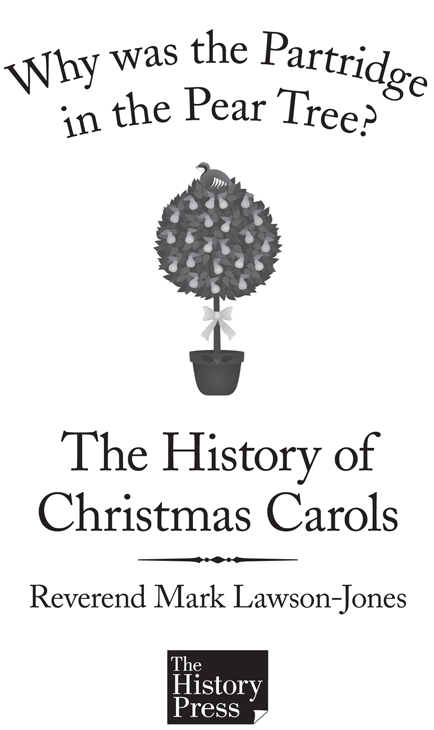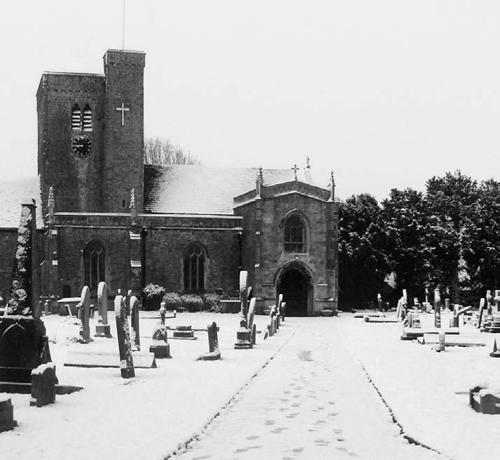Why was the Partridge in the Pear Tree?
Read Why was the Partridge in the Pear Tree? Online
Authors: Mark Lawson-Jones





1
Wassailing, Mari Lwyd and Singing in the Pub
2
The Puritans Tried to Kill Christmas
5
The Twelve Days of Christmas
7
Hark! the Herald Angels Sing
9
Angels from the Realms of Glory

As winter approaches and the days get shorter and darker, the shops and streets begin to fill with Christmas decorations and lights, and before we have managed to think of cards and presents, we start hearing Christmas carols all around us – on the radio, in TV commercials and as we shop in the supermarket. Christmas carols have become part of our culture and carol services are still popular in our churches and cathedrals as we hear of the message of the birth of Jesus and how God chose to visit his people. Carols were first sung in Europe thousands of years ago, although they were pagan songs and people danced as they sang and celebrated the Winter Solstice feast, the shortest day of the year.
The early Christians took over the pagan feast as the feast of the birth of Jesus Christ and they began to sing Christian songs, most of which were written in Latin. In the thirteenth century, St Francis of Assisi changed all that when he introduced the Christmas crib as a focus of devotion and also the Nativity Plays to communicate the message of Christmas. The people in the plays sang songs in their own languages and the audiences joined in the choruses and so the tradition of Christmas carols was established and they were sung by families in homes and churches and passed down from generation to generation. When Oliver Cromwell and the Puritans ‘banned’ the celebration of Christmas, people sang carols in secret and then in Victorian times they were collected from the villages and sung more widely. New carols were written and people enjoyed singing carols in schools and churches and in the streets. They even went from door to door and often collected money for charity at the same time.
In 1918, Eric Milner-White, the Dean of Kings College Cambridge introduced the now famous service of Nine Lessons and Carols to celebrate the ending of the First World War. It is still broadcast today and is a feature of many cathedrals, colleges and parish churches. More recently, churches have introduced the Moravian Christingle service, which along with Crib Services are very popular with children and adults alike.
Carols relate the wonder of the Christmas story told by St Luke about the birth of Jesus, who millions of Christians all around the world today acknowledge as their Lord and God. The story of the king of kings being born in a lowly stable to a young mother far from home often contrasts with our own homes and the Christmas lights and trees and the over-indulgence of food and drink. It is so easy to get caught up in the commercialism and celebrations that we forget the central message of Christmas, that God loved us so much that he gave us his Son to live among us.
Christmas carols contain the central message of that wondrous event when angels sang and shepherds and Wise Men came to worship – and we are also invited to worship the Christ-child. We may sing the carols without reflecting a great deal on the words we are hearing, so I hope this book will provide fresh insights into what we sing and make us think more deeply of what God has done for us. Mark Lawson-Jones has done a remarkable job in researching some of best loved carols and illuminating them with stories of how they were written and what they mean. I hope this beautiful book will bring pleasure to many and also provide an answer to that seasonal question of what to give friends and relatives for Christmas.
Dominic Walker OGS, Bishop of Monmouth

Christmas carols always seem to bring out the be.st in people. It’s as if we can travel back in time to a place where life was less complicated and Christmas was full of joy and magic. The churches fill with people and in our villages, towns and cities people meet to stand together in the cold to sing songs. ‘The Holly and the Ivy’, ‘O Come All Ye Faithful’ or ‘Once in Royal David’s City’ can fill us with hope for the future and renew our belief in humanity once again, even if it is a short-lived feeling.
Christmas has been a time of rest, celebration and sharing for many hundreds of years. However, as I wrote the chapters of this book I couldn’t help thinking that we seem to accept so much about Christmas carols and songs without questioning. Intermingled with the Christian imagery there are frequent mentions of evergreen plants, historic dances and practices and even ritual dating back to times long before the first Christmas. Much of this seems to go unquestioned and uninvestigated. Why was the partridge in the pear tree? Who was Good King Wenceslas? And what are the pagan origins behind ‘The Holly and the Ivy’?
I had always thought that many Christmas carols had their roots in the Middle Ages, but this turned out to be far from true. Whist researching this book I discovered how Christmas was nearly killed off in the sixteenth and seventeenth century, I discovered that the ‘Golden Age of Carols’ was the nineteenth century and I discovered carols that united soldiers on the Western Front during the First World War.
Last Christmas I officiated at the marriage of Jim and Alison Dennehy, in the historic setting of St Mary’s Church, in the village of Magor, South Wales. The service took place one week before Christmas and snow was on the ground. As the celebration of Christmas mingled with the celebration of the promises they made to one another I wondered why more couples didn’t opt for a marriage ceremony at this time of year. All the elements for a successful day were present; family, friends, food and drink. The Christmas carols really set the scene and made the day even more special as the couple started their married life together.

St Mary’s Church, Magor, in the snow.
What, then, is the history of this excellent tradition of singing carols and songs around Christmas that can add so much to special occasions? When did it all start?
Some suggest that the word carol derives from the Old French, or Middle English
carole
, meaning ‘to dance’. Alternatively, it could be related to the late Latin
choraula
, meaning ‘a choral song’. Whichever root the word originates from, we can be fairly certain that the ‘dancing’ element of caroling was relatively short lived, and the term has come to be associated with singing in a loud and joyous manner, in the pub, at home, in church or door to door. However they appeared first, Christmas carols are a firm tradition still celebrated today. What is intriguing is that although many carols describe religious events relating to the birth of Jesus Christ, evergreen plants such as the holly (
ilex aquifolium
) are frequently mentioned too. These facts are investigated in more depth later in this book and will point towards the rich history of carols and Christmas songs that have only really found a home in the church since the early nineteenth century. Before this, carols were more likely to be sung by wassailers and carolers in the squares, streets, pubs and homes of Britain.
